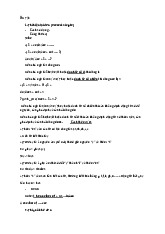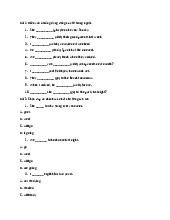



Preview text:
lOMoAR cPSD| 58511332
TOPIC 1: PEOPLE AND SOCIETY
Exercise 1 : Fill in the blank with the correct words Proposal ( n ) Commitment (n) Immigrant Residence Conflict (v,n) Affair (n) Mutual (adj) Native Companionship (n) Acquaintance (n) Empathise Inhabitant Resident Familiar Individual Population
1. The countries were able to resolve their border ________ through diplomatic negotiations.
2. The ________ came together to celebrate the annual festival.
3. Many teenagers tend to ________ their favorite celebrities. 4. Elderly individuals often
cherish the ________ of their pets.
5. Despite rumors of an ________, the celebrity couple remained silent about their personal lives.
6. Tom and Lisa had a ________ understanding that allowed them to work well together.
7. The new student found comfort in the ________ faces of classmates.
8. Each ________ has unique talents and strengths.
9. Long-lasting relationships require a strong ________ from both partners.
10. Sarah made many ________ at the networking event.
11. The city's newest ________ offers modern amenities.
12. John nervously presented his marriage ________ to Mary.
13. A good friend will always ________ with your feelings.
14. The preservation of ________ cultures is essential, even as ________ welcome and integrate
________ into their societies.
Exercise 2 : Circle the word which has different primary stress 15. A. Residence B. Immigrant C. Emphathize D. Commitment 16. A. Proposal B. Conflict C. Mutual D. Affair 17. A. Immigrant B. Familiar C. Individual D. Inhabitant 18. A. Resident B. Empathize C. Engineer D. Mutual 19. A. behave B. relax C. enter D. allow 20. A. Disaster B. Origin C. Charity D. Agency lOMoAR cPSD| 58511332
Exercise 3: Mark the letter A, B, C, or D on your answer sheet to indicate the word(s) OPPOSITE in meaning
to the underlined word(s) in each of the following questions.
Question 21: Judy has just won a full scholarship to one of the most prestigious universities in the
country; she must be now on cloud nine
A. extremely panicked B. obviously delighted
C. incredibly optimistic D. desperately sad Question
22: People nationwide have acted without to provide aids for the victims in the hesitation disaster- stricken areas. A. uncertainty B. willingness C. awareness D. reluctance
Exercise 4: Read the following passage and mark the letter A, B, c, or D on your answer sheet to
Indicate the correct word or phrase that best fits each of the numbered blanks from 31 to 35.
Finding Beauty in The City
Cities are known to have lives of their own, and photographers are able to (23) _________some of it.
Whether taking shots of people walking on a crowded street or time-lapse shots of cars driving at
night, the (24) _________ photos can be breathtaking. Because many of the shots taken are of man-
made objects like architecture, many emotions that come into (25)_________ wouldn’t be found in
nature photography. Photos can show the wonder of a child staring at fountain as water shoots upward
in the sunlight. They can also show the sadder side, such as a camp of homeless people living in terrible
poverty. (26) _________ of what they show, there is always beauty to be found, even if it is beauty in
something that is showing an ugly truth.
Depending on the time of the day, photos taken in an urban environment can change drastically. To see
the (35) _________ of a building as its shadow is cast on the lawn of a park is always amazing to see. 23. A. capture B. catch C. seize D. see 24. A. causing B. mentioning C. involving D. resulting 25. A. practice B. action C. play D. work 26. A. Regardless B. Due to C. Without D. Unaware 27. A. edge B. outline C. line D. description
Exercise 4: Read the following passage and mark the letter A, B, C, or D on your answer sheet to
indicate the correct answer to each of the questions from 36 to 42. Stones that Move
The American southwest is full of deserts. If you ever go there, you might get to see a very
strange event. We are talking something called the sailing stones. lOMoAR cPSD| 58511332
Sometimes, stones in the southwestern desert move by themselves. Wind doesn’t seem to
push them. People and animals don’t touch them. However, these stones still move. Sometimes
they travel more than a hundred meters. They always leave a trail in the sand behind them.
This is useful because we can look at the trail and figure out how far a stone has moved. How is
this possible? How can stones move all by themselves? Scientists have been studying this for
years. People have offered all kinds of theories. One of the earliest theories was that wind
pushes the stones. That theory isn’t correct, because some of the stones weigh more than 300
kilograms. When it seemed like there was no logical explanation for the sailing stones, people
started coming up with crazier ideas. Some people said that aliens were moving the stones, and
others said that clever people were playing a joke.
Finally, in 2013, a scientist came up with an explanation for the sailing stones. This scientist
normally studies weather on other planets, and when he heard about the sailing stones, he
became interested in them. He found out that ice forms on the bottom of the stones. When that
happens, even a very light wind can push the stone for long distances.
To prove his theory, the scientist did an experiment. He put a rock in his freezer and let some ice
form on it. Then, he put sand and a little water in a tray. Finally, he put his frozen rock on top of
the sand. When he blew on the rock, it moved. Even when he blew very gently, he had no problems moving the rock.
Here is something interesting about the sailing stones. Curious people visit the desert in the
southwest to see them. A lot of those people don’t like to hear the scientific explanation for the
sailing stones. Many people prefer to feel that the stones are still a mystery.
36. What was the first theory about the sailing stones?
A. People were playing a joke. B. Wind pushed them.
C. Ice formed on the bottoms of the stones.
D. Aliens were pushing the stones.
37. What kind of work did the scientist do before he studied the sailing stones?
A. He looked for life on other planets. lOMoAR cPSD| 58511332
B. He studied weather in deserts. C. He sold freezers.
D. He studied weather on other planets.
38. Why is it useful that the stones leave a trail?
A. We can know how fast the stones traveled.
B. We can know who is moving them.
C. We can know how heavy the stones are.
D. We can know how far they traveled.
39. The word “trail” in paragraph 2 is closest in meaning to________. '
A. a road B. a rail C. a path D. a distance
40. The word “that” in paragraph 4 refers to________.
A. stone sailing B. ice forming C. the bottom D. an experiment
41. What does the last paragraph tell us?
A. Some people prefer to believe that the sailing stones are still a mystery.
B. Many people don’t believe the scientist’s theory about ice.
C. Fewer people are interested in the sailing stones because they are not a mysteryanymore.
D. Many scientists have different explanations about the sailing stones.
42. What can be inferred from the scientist’s experiment?
A. The light wind can move very small rocks.
B. Sand and water in a tray makes rocks move.
C. The experiment in the freezer is far different from the real situation.
D. The friction between the stones and the ice is small.




